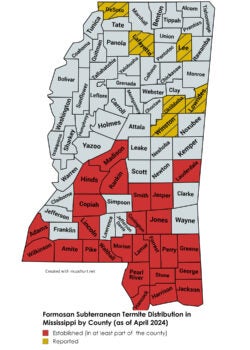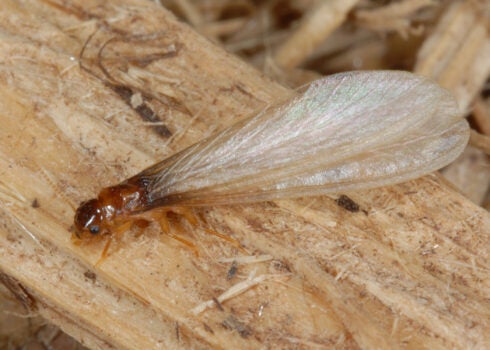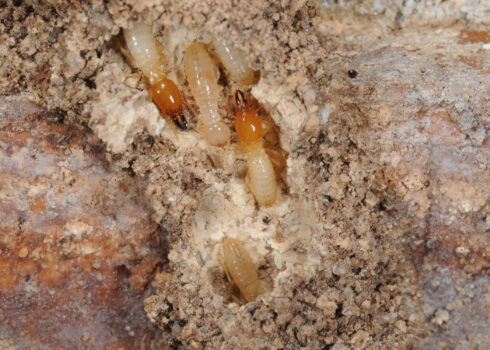Formosan termite swarms threaten large part of state
Published 1:37 pm Friday, April 12, 2024
By Bonnie Coblentz
MSU Extension Service
Invasive Formosan subterranean termites were first found in the state 40 years ago, and soon, these dangerous pests will swarm and threaten unprotected structures in about one-third of Mississippi’s counties.
Santos Portugal, Mississippi State University Extension Service urban entomologist, said Formosan termites typically swarm in the millions from early May to early June. They have the ability to infest and significantly damage structures much more quickly than native subterranean termites.
“Swarming Formosan termites are reproductive, winged alates that go out on mating flights from established colonies,” Portugal said. “They pair off, mate, detach their wings and look to establish a new colony.”
Like the native Eastern subterranean termites, they typically infest structures from the ground, but Formosan infestations also can occasionally arise from a mated pair of swarmers finding moist wood on a roof or above ground.
“If a colony starts this way, traditional soil-based termite preventative treatments are not effective,” Portugal said.
Formosan termites were first discovered in Mississippi in Lauderdale County in 1984. Portugal said today, they are considered established in at least part of 26 primarily southern counties, but they potentially can be encountered anywhere in the state.
“There have been Formosans collected from or near Starkville, Columbus, Louisville, Olive Branch, Tupelo and Oxford within the last decade, but these appeared to be isolated cases, and it is not known if Formosans are truly established that far north,” he said.
Formosan swarmers are about one-half inch long, including their wings, and are yellow to golden brown. Native subterranean termite swarmers are smaller and are dark brown to black in comparison.
“When a Formosan colony is established in a structure, their swarmers will often emerge indoors from what is known as a swarm castle,” Portugal said. “These irregular spots of dry mud can appear overnight in late spring and are often found on the ceiling or higher up on walls.
“Established colonies can develop a carton nest, which allows them to sever their connection to the soil for moisture, making them more difficult to find and treat,” he said.
Outdoors, Formosan colonies can be enormous, containing more than a million termites over an area the size of a football field or larger. They also actively infest live trees, weakening limbs and trunks.
Another difference between Formosan and native termites is that Formosans swarm at night and are highly attracted to light. Native subterranean termites swarm during daytime hours, usually in mid-February to mid-May.
“In some coastal areas with high Formosan activity, massive swarms at night will be found around streetlights and have even been picked up on weather radar,” Portugal said.
Blake Layton, Extension entomologist, said due to the high level of termite activity in the state, anytime swarmers are noticed is a good reminder to take action to protect structures.
“If you find swarmers outdoors near your house, consider reaching out to a qualified pest management company to have an inspection conducted on your home,” Layton said. “This is especially true if you don’t have a current termite contract and do not know when the building was last treated.”
A termite contract with a reputable pest control company includes an annual inspection for termites by a pest management professional and additional needed treatments at no extra cost.
“The best way to protect your home or building from termites is to be sure it has been preventively treated for termites and that the termite treatment is current and nothing has happened to compromise its effectiveness,” Layton said.
Contracts differ between companies, and it is important to understand what is outlined in the agreement before committing.
“Not all companies cover Formosan subterranean termites in their contracts,” he said.
Many structures use spray foam insulation, but experts warn this can hide leaks and termite activity, potentially resulting in extensive damage before an infestation is detected.
Submit any suspected Formosan subterranean termite activity occurring outside the cited counties to the MSU Extension Insect ID Lab. For more information, visit http://www.ext.msstate.edu/insects/insect-identification. To learn more about termites, visit https://extension.msstate.edu/termites.








